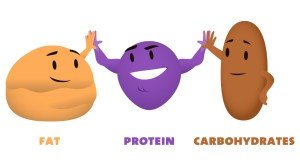Fat 101
 Whether you follow a low-fat diet or prefer a higher-fat Mediterranean eating style, the reality is that fat is an essential component of our food choices, necessary for good health. We’ve see-sawed between fat-free eating plans to high-fat plans that involve adding butter to coffee. Just like in so many things, the middle ground may be the right place. Let’s take a closer look at fat!What is Fat?Fats in foods supply calories and essential fatty acids. They also aid the absorption of fat-soluble vitamins A, D, E, and K.Fat, carbohydrate, and protein are the three macronutrients in our foods that provide calories used for energy. Fats provide more calories per gram than any other calorie source — 9 calories per gram vs 4 calories per gram in protein and carbohydrate.There are four different types of fat: saturated, trans, monounsaturated, and polyunsaturated. Each type has different physical properties based on its chemical make-up. That said, all types of fat contain the same number of calories per gram.What Foods Contain Fat?Some fat is found naturally in foods like nuts, seeds, avocado, olives, milk, cheese, yogurt, fish, chicken, and meat. We also add fat to foods when cooking or at the table — think butter, margarine, mayonnaise, sour cream, salad dressing, etc. Vegetable oils such as canola, corn, soybean, safflower, tropical oils, olive oil, and oils from nuts or seeds are used in cooking too. Foods absorb fat from frying, sautéing, and deep-fat frying as well. Most Americans consume too much fat overall, which can contribute to a higher calorie intake and overweight or obesity.Where Does Fat Fit Into a Healthy Eating Pattern?Since not all fats have the same health effects, and most people eat too much fat in general, incorporating fat into an eating plan requires a bit of know how.Here are some top tips…
Whether you follow a low-fat diet or prefer a higher-fat Mediterranean eating style, the reality is that fat is an essential component of our food choices, necessary for good health. We’ve see-sawed between fat-free eating plans to high-fat plans that involve adding butter to coffee. Just like in so many things, the middle ground may be the right place. Let’s take a closer look at fat!What is Fat?Fats in foods supply calories and essential fatty acids. They also aid the absorption of fat-soluble vitamins A, D, E, and K.Fat, carbohydrate, and protein are the three macronutrients in our foods that provide calories used for energy. Fats provide more calories per gram than any other calorie source — 9 calories per gram vs 4 calories per gram in protein and carbohydrate.There are four different types of fat: saturated, trans, monounsaturated, and polyunsaturated. Each type has different physical properties based on its chemical make-up. That said, all types of fat contain the same number of calories per gram.What Foods Contain Fat?Some fat is found naturally in foods like nuts, seeds, avocado, olives, milk, cheese, yogurt, fish, chicken, and meat. We also add fat to foods when cooking or at the table — think butter, margarine, mayonnaise, sour cream, salad dressing, etc. Vegetable oils such as canola, corn, soybean, safflower, tropical oils, olive oil, and oils from nuts or seeds are used in cooking too. Foods absorb fat from frying, sautéing, and deep-fat frying as well. Most Americans consume too much fat overall, which can contribute to a higher calorie intake and overweight or obesity.Where Does Fat Fit Into a Healthy Eating Pattern?Since not all fats have the same health effects, and most people eat too much fat in general, incorporating fat into an eating plan requires a bit of know how.Here are some top tips…
- Plan meals and snacks to include fruits, vegetables, whole grains, low-fat dairy products, poultry, fish and nuts that are lower in saturated fat and contain more monounsaturated and polyunsaturated fats.
- Use naturally-occurring, unhydrogenated vegetable oils such as canola, safflower, sunflower or olive oil instead of solid fats like butter, margarine, and lard.
- Look for processed foods made with unhydrogenated oil rather than partially-hydrogenated or hydrogenated vegetable oils or saturated fat.
By Lynn Grieger, RDN, CDE, CPT, CWCReferences:
- Dietary Guidelines for Americans 2010. http://health.gov/dietaryguidelines/dga2010/DietaryGuidelines2010.pdf
- Fat 101. American Heart Association. http://www.heart.org/HEARTORG/GettingHealthy/FatsAndOils/Fats-101_UCM_304494_Article.jsp#.VkpG_3arT9g
- Trans Fats. American Heart Association. http://www.heart.org/HEARTORG/GettingHealthy/NutritionCenter/HealthyEating/Trans-Fats_UCM_301120_Article.jsp#.VlkAzHarT9g